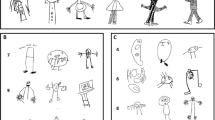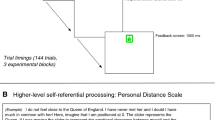Abstract
This pilot study aimed to detect indicators within self-figure drawings that reflect stuttering in adults. A sample of 20 adults who stutter from childhood were given a blank sheet of A4-size paper and a pencil and were asked to draw themselves. Their drawings were compared to drawings of a nonstuttering adult group that was matched to the study group according to age, gender, and education (n = 20). Indicators included all body organs that symbolize the senses and social anxiety (based on the literature review) were selected for comparison. Findings revealed that the ears, eyes, and throat of figures drawn by the stuttering adults differed from those drawn by nonstuttering adults. In addition, stuttering adults tended to add a collar or a line within the neck to their drawings.
Similar content being viewed by others
References
Breathnach, C. S. (2000). Scanning the stammering brain. Irish J. Psychol. Med. 17(4): 140–142.
Craig, A. (2000). The developmental nature and effective treatment of stuttering in children and adolescents. J. Dev. Phys. Disabil. 12(3): 173–186.
Crichton, S. I. (2002). Communication in the real World: Accounts from people who stammer. J. Fluency Disord. 27(4): 333–352.
Davis, S., Howell, P., and Cooke, F. (2002). Sociodynamic relationships between children who stutter and their non-stuttering classmates. J. Child Psychol. Psychiatry Allied Discipl. 43(7): 939–947.
Gillespie, J. (1994). The Projective Use of Mother-and-Child Drawings, Brunner/Mazel, New York.
Ginsberg, A. P. (2000). Shame, self-consciousness, and locus of control in people who stutter. J. Genetic Psychol. 161(4): 389–399.
Ginsberg, A. P., and Wexler, K. B. (2000). Understanding stuttering and counseling clients who stutter. J. Ment. Health Counsel. 22(3): 228–239.
Hugh, J. S., and Smith, P. K. (1999). Self-reports of short and long term effects of bullying on children who stutter. Br. J. Educ. Psychol. 69(2): 141–158.
Johnson, G. S. (1989). Emotional indicators in the human figure drawings of hearing-impaired children: A small sample validation study. Am. Annals. Deaf 134(3): 205–208.
Kraaimaat, F. W., Vanryckeghem, M., and Van Dam Baggen, R. (2002). Stuttering and social anxiety. J. Fluency Disord. 27(4): 319–331.
Lev-Wiesel, R., and Yosipov-Kaziav, J. (accepted for publication). Deafness as reflected in self-figure drawings of deaf people. J. Dev. Phys. Disabil.
Liu, Y., Shi, W., Ding, B., Li, X., Xiao, K., Wang, X., and Sun, X. (2001). Analysis of correlates in the SAS, the SDS, and the MMPI of stutteres. Chin. J. Clin. Psychol. 9(2): 133–134.
Machover, K. A. (1949). Personality Projection in the Drawing of the Human Figure, C. C. Thomas, Springfield, IL.
Menzies, R. G., Onslow, M., and Packman, A. (1999). Anxiety and stuttering: Exploring a complex relationship. Am. J. Speech Lang. Pathol. 8: 3–10.
Oster, G. D., and Montgomery, S. S. (1996). Clinical Uses of Drawings, Jason Aronson, Northvale, New Jersey.
Susca, M. (2001). Perception of brief time interval durations in people who do not stutter. Dissert. Abstr. Int. Sect. B Sci. Eng. 62(6-B): 2685.
Yaruss, J. S. (2001). Evaluating treatment outcomes for adults who stutter. J. Commun. Disord. 34(1–2): 163–182.
Author information
Authors and Affiliations
Corresponding author
Rights and permissions
About this article
Cite this article
Lev-Wiesel, R., Shabat, A. & Tsur, A. Stuttering as Reflected in Adults’ Self-Figure Drawings. J Dev Phys Disabil 17, 85–93 (2005). https://doi.org/10.1007/s10882-005-2203-z
Issue Date:
DOI: https://doi.org/10.1007/s10882-005-2203-z




